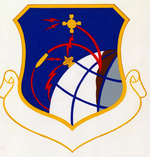Western Range (USSF)
This article focuses only on one specialized aspect of the subject. (July 2013) |
| Part of a series on the |
| United States space program |
|---|
  |

The Western Range (WR)
History
The Navy established the Naval Missile Facility at Point Arguello (NMFPA) after the transfer from the Army of 19,800 acres from the southern portion of Camp Cooke in May 1958. Camp Cooke was a World War II training and POW facility and a maximum security Disciplinary Barracks site.[6] Cooke Air Force Base, later Vandenberg Space Force Base, was established on 64,000 acres of the northern portion.[6] The Secretary of Defense directed the Navy to establish the Pacific Missile Range (PMR) with headquarters at Point Mugu and instrumentation sites along the California coast and downrange in the Pacific Ocean.[6] Agreements between the Navy and the Air Force specified that nearly all launches from Vandenberg Space Force Base were under the command and control of Navy and the PMR.[6]
A Pacific
Air Force — Western Test Range
Secretary of Defense
Notable launches
- 28 February 1959 - Discoverer 1 - first spacecraft placed in a polar orbit.[6][9]
- 29 September 2013 – separates from the booster, the booster will do a retro burn to reduce velocity from approximately Mach 10 (12,300 km/h; 7,610 mph) to a controllable descent velocity, and then a second burn just before it reaches the water to simulate a vertical landing of the first stage.[11] This will be the first high-altitude, high-velocity test of the SpaceX reusable launch system development program.
See also
- Eastern Range
- Missile Range Instrumentation Ship
References
- ^ Federation of American Scientists.
- ^ "Chapter 1: Eastern and Western Range Safety Policies and Processes 31 December 1999 Change to 1997 EWR" (PDF). Retrieved 31 August 2008.
- ^ a b Center for Aerospace Technology (CAST) (February 2000). "30th SPACE WING / VANDENBERG AIR FORCE BASE LAUNCH SITE SAFETY ASSESSMENT" (PDF). Research Triangle Institute Center for Aerospace Technology (CAST). Federal Aviation Administration Associate Administrator for Commercial Space Transportation. Retrieved 31 August 2008.
- ^ Loyd C. Parker; Jerry D. Watson; James F. Stephenson (July 1989). "BASELINE ASSESSMENT WESTERN SPACE AND MISSILE CENTER" (PDF). RESEARCH TRIANGLE INSTITUTE CENTER FOR SYSTEMS ENGINEERING FLORIDA OFFICE for U.S. DEPARTMENT OF TRANSPORTATION OFFICE OF COMMERCIAL SPACE TRANSPORTATION. Archived from the original (PDF) on 9 August 2016.
- ^ Janene Scully (14 July 2003). "New leader of Western Range signed at VAFB" (PDF). Santa Maria Times. Pulitzer Central Coast Newspapers. Retrieved 2 June 2008.
- ^ a b c d e f g h i j 30th Space Wing History Office.
- ^ Subcommittee on Military Construction (March-April) (29 April 1959). Military Construction Appropriations for 1960: Hearings. pp. 169–170. Retrieved 16 September 2020.
- ^ Subcommittee on Military Construction (May) (20 May 1959). Military Construction Appropriations for 1960: Hearings. pp. 818, 824. Retrieved 16 September 2020.
- ^ "NASA - NSSDC - Spacecraft - Details NSSDC ID: 1959-002A". Retrieved 31 August 2008.
- ^ Foust, Jeff (27 March 2013). "After Dragon, SpaceX's focus returns to Falcon". NewSpace Journal. Retrieved 5 April 2013.
- ^ Lindsey, Clark (28 March 2013). "SpaceX moving quickly towards fly-back first stage". NewSpace Watch. Retrieved 29 March 2013.
Bibliography
- "Western Range (U)". Federation of American Scientists. Retrieved 16 June 2015.
- Gruss, Mike (6 April 2015). "Raytheon Team Wins US$2 Billion Air Force Range Support Contract". SpaceNews. Retrieved 8 April 2015.
- 30th Space Wing History Office. "U.S. Air Force Fact Sheet". 30th Space Wing Public Affairs. Archived from the original on 10 January 2015. Retrieved 16 June 2015.
{{cite web}}: CS1 maint: numeric names: authors list (link)
- Western Test Range Handbook, Defense Technical Information Center, July 1981
